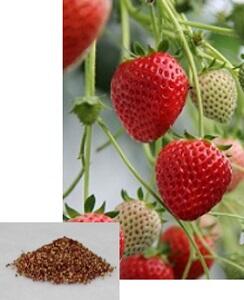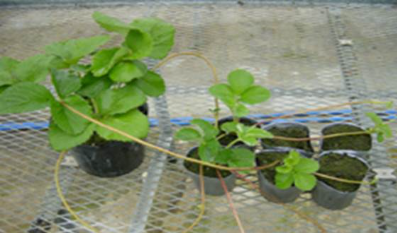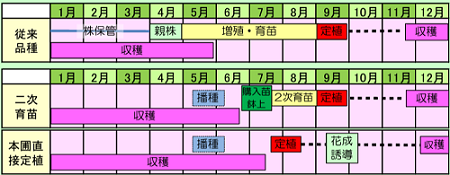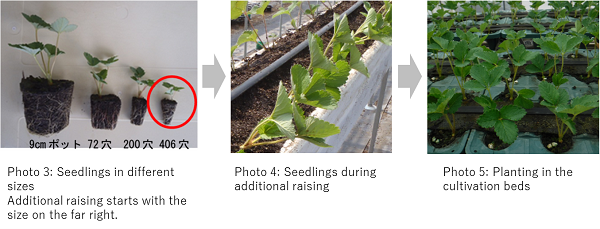(This is an English translation of the original Japanese article.
The publication date refers to that of the Japanese version,
which differs from the upload date of the English version.)
The new strawberry variety, Yotsuboshi* (photo 1, also see Glossary), which can be propagated by seeds, was developed and registered in 2017. This new variety has been steadily increasing its cultivation area, reaching 14.2 hectare in 2018, 30.9 in 2020, and 39.4 in 2022. Interest in seed propagation type of strawberries is growing, and recently, major seed companies have announced their full-scale entry into the business of developing new seed propagation strawberries.
However, seed propagation strawberries differ from traditional vegetative propagation ones, which multiply seedlings by runners (leafless stalks) arising from mother plants, in terms of seedling raising methods and growth characteristics. Therefore, it was necessary to establish a new cultivation management system.
This episode 53 introduces a study by a research group of nine institutions, led by the Mie Prefecture Agricultural Research Institute. They worked on the development of cultivation methods suitable for the new variety Yotsuboshi, established a system that significantly reduces the labor required for seedling raising by taking advantage of the characteristics of seed propagation type, and developed a publicly available manuals.

Photo 1: The fruits and seeds of Yotsuboshi strawberry
(provided by the Seed-Propagating Strawberry Research Institute)
What is a seed propagation strawberry?
Most of the strawberry varieties currently cultivated are of the vegetative propagation type, where seedlings are produced by runners arising from mother plants(photo 2). This is because even if seeds are collected from such strawberries and sown, they do not result in strawberries with exactly the same traits as the mother plant. On the other hand, since the seedlings produced by runners are clones of the mother plant with the same genetic composition, this vegetative propagation type can produce uniform seedlings. On the downside, if the mother plant is infected with pests, there is a high risk that the seedlings will inherit them. Most pests do not transmit through seeds, so in the case of seed propagated strawberries, there is hardly any inheritance of pests from the mother plant.

Photo 2: Runners arising from mother strawberry plant and seedlings produced by the runner
(provided by the Seed-Propagating Strawberry Research Institute)
Strawberry cultivation requires about 7,000 seedlings per 10 ares (100m2). For vegetative propagation type of strawberries, it takes a lot of time and effort for farmers to secure the necessary seedlings. Each mother strawberry plant produces 20 to 40 seedlings. These are gradually multiplied and supplied from public research stations in prefectures to agricultural cooperatives, and from there to strawberry farmers. In addition, farmers themselves also raise the seedlings needed for the next year's production alongside strawberry fruit production. In contrast, seedlings of seed propagation type can be mass-produced by seedling companies because their propagation efficiency is more than 40 times of that of vegetative propagation type.
For farmers, by purchasing healthy seedlings of seed propagation type of strawberries from seedling companies, they don't have to spend the period from May to August any more on multiplying and raising their own stored strawberry seedlings. This also significantly reduces the labor required for seedling raising, and does not need maintaining the mother plants, which is required for the vegetative propagation type. There is also a system in which farmers directly plant the purchased seedlings without additional raising. If the cultivation system of seed propagation type of strawberries is established, it will bring about a major transformation in the production system of strawberries, allowing seedling companies and farmers to separate the roles of seedling raising and fruit production.
Establishing cultivation systems that utilize the characteristics of seed propagation type
The research group worked on establishing labor-saving and efficient cultivation systems that can utilize the characteristics of seed propagation type, utilizing small seedlings (plug seedlings) grown from seeds, while also leveraging the accumulated cultivation knowledge of the farmers. As a result, they have established a system suitable for the new seed-propagation variety Yotsuboshi, such as the "Planting after Additional Raising System" and the "Direct Planting System" (figure 1).

Figure 1: Cultivation schedules by cultivar/system
(provided by Mie Prefecture Agricultural Research Institute)
Planting after Additional Raising System: After raising the plug seedlings in pots for about two months, they are planted in the cultivation beds. It is similar to traditional methods and has a low risk.
Direct Planting System: Plug seedlings are directly planted in the cultivation beds. It saves labor significantly and seedling-raising facilities are not required.
The "Planting after Additional Raising System" is a method where the farmers further raise the plug seedlings purchased from the seedling company and then plant them in the cultivation beds. The farmers purchase plug seedlings (photo 3, in red circle), which are raised in 406 cell plug trays (approx. 1,500 cm2), and put them in polyethylene pots from late June to July, then further raise them into a size and condition suitable for planting by late August (photo 4). It has been confirmed that, when the fertilization is interrupted to induce flower buds and the seedlings start to initiate flower buds in the cultivation beds in September (photo 5), fruits of the seed propagation strawberries can be harvested from late November to mid-June of the following year, under the same cultivation management as traditional varieties. This method does not require any additional procedure involving equipment or facilities other than the purchase of plug seedlings, and there is no need to maintain mother plants or produce seedlings by runners, so farmers can reduce the working hours for seedling raising by about 30% compared to traditional vegetative propagation type of varieties.

(provided by the Seed -Propagating Strawberry Research Institute)
The "Direct Planting System" involves purchasing plug seedlings from a seedling company and planting them directly in the cultivation beds from July to August. Plug seedlings raised in 406 cell plug trays are used, but depending on the time, seedlings raised in 200 or 72 cell plug trays may be also used. After growing the seedlings in the beds, flowering can be induced either by suspending fertilization from mid-August to late September, or conducting lighting for 24 hours a day for about two weeks from mid-September, and then the strawberries can be harvested from around mid-December. This cultivation method also requires the purchase of plug seedlings, but it eliminates the need for facilities for raising seedlings, reduces the labor of seedling raising and planting by 90%, extends the harvest period, which is from late November to late May of the following year in the vegetative propagation type, to from mid-December to mid-July of the following year. It has been also confirmed that the yield increases.
In addition, a cultivation system in which farmers cultivate the strawberries from seeds has also been established. The germinated seedlings are transferred one by one to polyethylene pots, and after that, they are managed in the same way as the "Planting after Additional Raising System". With these steps, the cost of purchasing seedlings is reduced to about half compared to the "Planting after Additional Raising System." However, careful management is needed since it takes skills to germinate strawberry seeds, and seedlings just after germination are vulnerable to environmental changes and pests that invade from outside.
Networking producers to promote Yotsuboshi strawberries
The research group worked on verifications of the "Planting after Additional Raising System" and the "Direct Planting System" in five prefectures: Iwate, Toyama, Mie, Yamaguchi, and Kagawa, and has established cultivation systems suitable for the weather and production and distribution conditions in each region. The established methodologies are being disseminated through research extension centers and agricultural cooperatives in these five prefectures. For farmers in other prefectures, cultivation manuals are provided through a newly established website
(https://seedstrawberry.com/index.html)in an effort to disseminate it nationwide. This website was initially created by seedling companies that received permission for seed production of "Yotsuboshi," and is now being taken over by the "Seed-Propagating Strawberry Research Institute", a general incorporated association that is responsible for disseminating the research results.
As an outcome of the research group's efforts to establish cultivation methods and promote them, the estimated cultivation area of "Yotsuboshi" has been steadily increasing, with 14.2 hectare in fiscal 2018, 30.9 in 2020, and 39.4 in 2022.
Mr. Toshiki Mori, the research representative (former researcher at Mie Prefecture Agricultural Research Institute, current Secretary-General of the Seed-Propagating Strawberry Research Institute), said, "'Yotsuboshi' is intended to be the first successful example of seed propagation type of strawberries. It is a very delicious variety, and I believe it will be widely accepted by everyone. As the cultivation of 'Yotsuboshi' becomes more widespread, further variety development will be promoted, and seed propagation varieties will eventually dominate strawberry cultivation."
Further advancement of variety development stimulated by Yotsuboshi example
Seed propagation type of strawberries can be multiplied efficiently, and their characteristics allow for securing many healthy seedlings. With the establishment of their cultivation methods, it has become possible to produce strawberries using a large number of seedlings from suppliers such as seedling companies. At Hananoumi (meaning "sea of flowers" in Japanese) Corporation in Yamaguchi Prefecture, they are utilizing the results of this research and conducting cultivation on a large scale using the "Direct Planting System." In addition, applying the results of this research, seed propagation varieties following "Yotsuboshi", such as "Berry Pop SUZU" and "Berry Pop HARUHI", have also been developed. Recently, major seedling companies have begun to fully enter the business of developing new seed propagation type of strawberries. It is expected that these movements will further progress in the future.
Glossary
*Yotsuboshi is the seed propagation type of strawberry variety that has been used for commercial growing for the first time in Japan. It was jointly developed and cultivated by Mie, Kagawa and Chiba prefectures and Kyushu Okinawa Agricultural Research Center of National Agriculture and Food Research Organization (NARO), and has been registered as a variety in 2017. The name "Yotsuboshi" ("four-star" in Japanese) implies its four-star level taste fulfilling four tasting elements: sweetness, sourness, flavor and deliciousness. It also has the meaning that it is a promising variety jointly developed by four institutions mentioned above.
URL for the "Short Read: Intro to Tech Achievements" series:
https://www.naro.go.jp/laboratory/brain/english/press/stories/index.html
Project name
The special scheme project on regional developing strategy
Project period
FY2016-2018
Title
The Establishment of Labor-Saving Cultivation Systems and a Producer Network using ICT for Nationwide Promotion of the Seed Propagation Strawberry Variety "Yotsuboshi"
Leading research institutes
Mie Prefecture Agricultural Research Institute (representative institution)
Iwate Agricultural Research Center
Horticultural Research Institute, Toyama Prefectural Agricultural, Forestry & Fisheries Research Center
Yamaguchi Prefectural Agriculture & Forestry General Technology Center
Kagawa Prefectural Agricultural Experiment Station
Miyoshi Agri-Tech Co., Ltd.
Hananoumi Corporation
Kyushu Okinawa Agricultural Research Center, NARO
Specified Non-profit Organization for the Research and Development of
Advanced Biotechnology in Tokai Region
